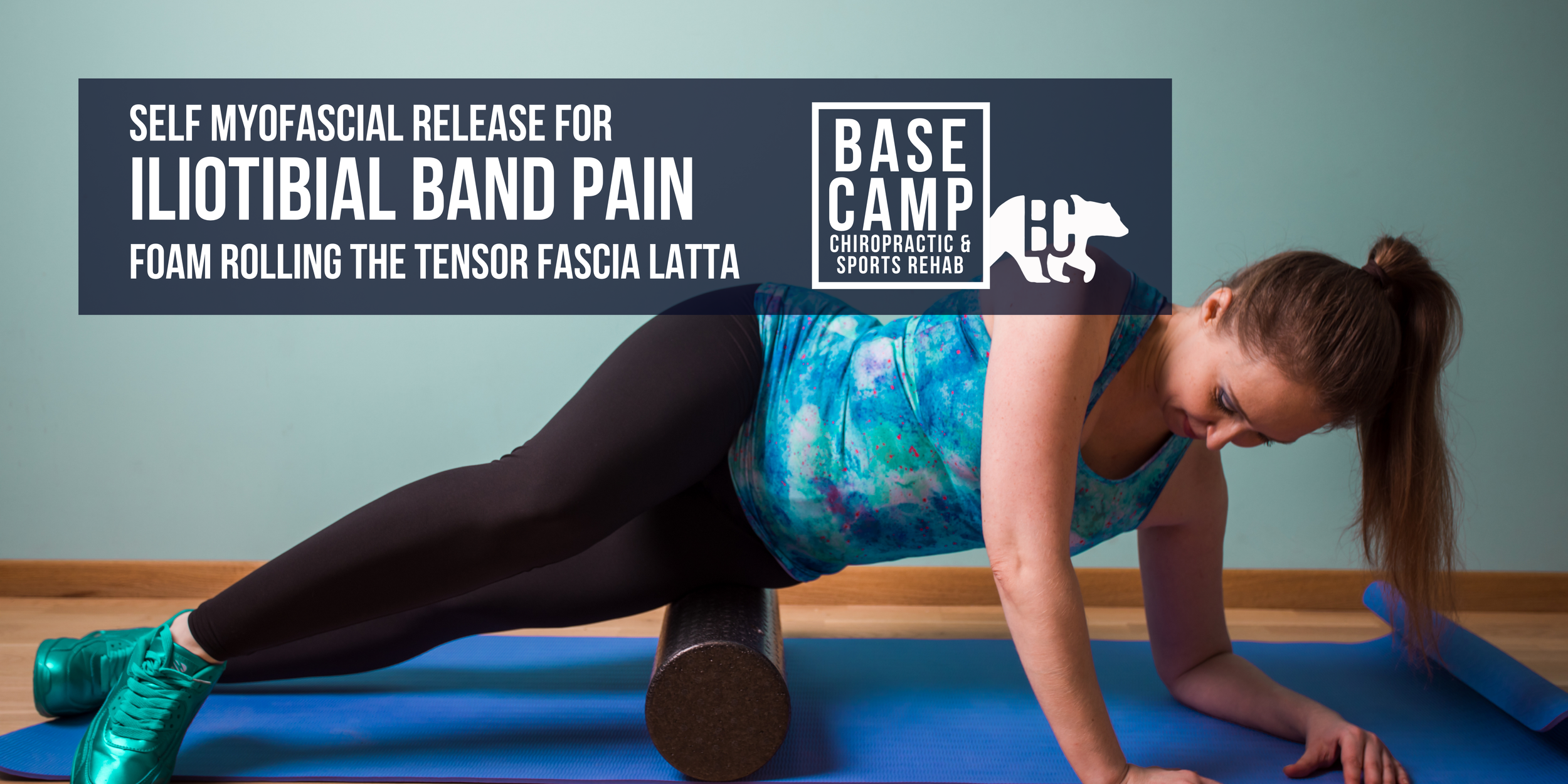
Blog
want to take a crack at your problems from home? Check out our blog posts and find the topics specific to you
Topics:
Iliotibial Band Pain
IT Band Syndrome is one of the MOST COMMON running injuries. But it does not have to keep you out forever. Learn about what causes it and how to manage it.
The Iliotibial Band (ITB) Pain is a show stopper.
It is the number one cause of lateral knee pain in runners (i.e. pain on the outside of the knee), and can not only end your running season, but it can also interfere with your everyday life.
If you have ever experienced ITB pain, you know how frustrating it can be.
In this article, we will cover what the ITB is, why it’s important, how it gets hurt, and some management recommendations.
What is Iliotibial band pain? And what even is the IT Band?
The IT Band is a length of connective tissue that connects your pelvis and your knee, running along the outside of the thigh. It helps make you more efficient while running by preserving the energy produced when your foot hits the group and reusing it for your next step.
Where the IT Band attaches at the knee can become irritated in many runners. This happens when you either increase your running volume too fast, spend too much time running downhill or run with a really narrow gait. It is particularly prevalent in trail runners because the trail forces our gait to narrow and we tend to spend a LOT of time running down hills (it IS my favourite part of trail running, after all!).
Once IT Band pain starts, it is really hard to get rid of, for a lot of reasons. Primarily though, it is because most runners follow this pattern:
Initial Injury happens
>Offload the tissue by decreasing your running volume.
>>Tissues lose capacity and your fitness goes down, but your pain decreases.
>>>Runner returns to their same activities as before, without properly rehabbing their knee.
>>>> Reinjury… and the cycle continues.
To prevent recurrent knee pain from the IT Band you HAVE TO BREAK THE CYCLE of Injury-Offload-Reinjury.
The good news is that IT Band pain doesn’t mean anything is DAMAGED. It just means that the knee is IRRITATED.
Management and Rehab of Iliotibial Band Pain
So… what should you do about IT Band Pain?
IT Band Pain management takes place in 3 Steps:
1) Calm Stuff Down
The nature of running injuries means that RUNNING VOLUME was the primary cause of the injury. This means that a temporary decrease in running is necessary to help calm down your symptoms, and your pain sensitivity. In the case of IT Band pain, this means avoiding running downhill. Some people can tolerate running on level terrain or using a treadmill on an incline. This helps keep your fitness up while rehabbing the injury.
During this phase we also use foam rolling, stretching, and manual therapy to decrease your pain and keep you as active as you can be. Here are some helpful videos:
Once things have calmed down (usually 2-6 weeks), then we can move on to Step 2 and Build Back Up.
2) Build Back Up
During this phase, we use exercises to increase your strength and tolerance to loading the knee. Here are some of my favourite exercises for rehabbing IT band pain:
Rear Foot Elevated Split Squat: VIDEO
Side Bridge: VIDEO
Box Step Downs: VIDEO
Lateral Lunge: VIDEO
3-Direction Calf Raises: VIDEO
This is just a short list of some of the things we use during the Build phase, but they are the foundation for most of the IT Band rehab programs I put together.
3) Bridge the Gap (getting Back to Running!)
This is both the most fun and most frustrating phase of IT Band rehab because you are going to want to jump back in and hit those trails you were running before the pain started.
This stage is different for each person, depending on their individual needs.
Stage 3 is a gradual process. How Stage 3 goes depends on how patient you can be. It is natural to want to jump back into running the same routes for the same distances at the same pace as you were before the injury. But what we want to do is gradually build your running volume back up over time instead.
If you can do that, not only will you be more successful at rehabbing your injury, you can actually become a faster and stronger runner than you were before the injury.
It is normal to have some bad days, where you feel like you are back to Stage 1. What we want to avoid is multiple consecutive days of flare-ups. Running volume management and terrain choice are essential at this stage.
Author: Dr Mark Murdoch, Chiropractor and Co-Founder at Base Camp Chiropractic and Sports Rehab in Vernon, BC.
Mark Murdoch is a Doctor of Chiropractic with a Master’s Degree in Sports Medicine.
Contact: drmurdoch@basecampclinic.com
Instagram: Base.Camp.Doc
Downhill Running and Knee Pain
Ever wonder why downhill running always leaves you so much sorer than flat or even uphill running?
Why running downhill makes you sorer than flat or uphill running.
Almost every experienced runner will agree: downhill running leaves you way sorer.
Have you ever wondered why?
There are two typed of soreness that people experience after running. These are muscular soreness and joint soreness.
Muscle Soreness
Muscular soreness is thought to be from damage to the muscle. This damage is microscopic and natural. Your body repairs this type of damage every day. When you are running downhill, your quads, hamstrings, and glutes primarily use a type of contraction called an eccentric contraction. Eccentric contractions are when the muscle is lengthening under resistance. This type of muscle contraction causes more damage than isometric (when the joint doesn’t move) or concentric contraction (when the muscle shortens).
Our muscles are MUCH stronger at eccentric contractions than concentric ones. This is why your legs can handle the force of downhill running, which can reach 7x our body weight in a single step.
This increased force also contributes to more muscle damage, and, you guessed it, more soreness.
Joint Soreness
Joint soreness has a variety of causes but often happens because of cartilage compression due to impact or swelling after activity.
The cartilage in our knees relies on water to absorb the impact of each step. When our cartilage is damaged, the knee’s ability to store water and manage that impact is lessened, and we get more inflammation and swelling.
This can happen because of prolonged and repetitive impact (like ultra running) or shorter, high-impact running (like downhill running).
When it comes to downhill running, we are dealing with much higher forces on the joint, and that can lead to soreness.
What does this mean for you, as a runner?
Neither type of soreness automatically means lasting damage to your muscle or joints, but it is important to respect the healing process. If you are coming off of a long run with a lot of hills, it is a good idea to stick to a flat run or a shorter run.
If you have had knee issues in the past and are looking to get back into running, you need to keep this in mind. It does not mean that you cannot run hills, but it does mean that you should respect the stress that downhill running places on your knees and make sure you are taking the time to recover from them. BOTH of these types of soreness are often delayed a few hours, or even a day or so, after activity, so you won’t even know the impact a run has had on you right away.
This also has important implications for me when I am working with runners who have a history of knee pain. Often we use flat or even mild-grade uphill running during the rehab process. I often have my patients stick to walking the downhill, or avoiding the downhill all together until we have built up the strength and tolerance of the legs and knees to the demands of downhill running.
Author: Dr Mark Murdoch, Chiropractor and Co-Founder at Base Camp Chiropractic and Sports Rehab in Vernon, BC.
Mark Murdoch is a Doctor of Chiropractic with a Master’s Degree in Sports Medicine.
Contact: drmurdoch@basecampclinic.com
Book a free Consult with Dr Murdoch: book here
Instagram: Base.Camp.Doc
Disclaimer: This blog is intended for general informational purposes only and is not intended for the delivery of medical advice. No doctor/patient relationship is formed. The use of information on this blog or materials linked from this blog is at the user's own risk. The content of this blog and website is not intended to be a substitute for medical advice.
Why the ankle you rolled in high school still bothers you
Most ankle sprains heal within a month.
Or at least… the pain goes away.
So why would an ankle sprain that is years old still bother you?
It is because you didn’t follow a progressive rehab plan.
Most ankle sprains heal within a month.
Or at least… the pain goes away.
So why would an ankle sprain that is years old still bother you?
It is because you didn’t follow a progressive rehab plan.
Healing takes place in three stages
Stage 1: Inflammation. During this stage, your body is sending all the building blocks to the injured area. This is typically painful and you might have some swelling or pain with movement. Pain to the touch. Discomfort walking. With a Grade 1 ankle sprain, this stage typically lasts a couple of weeks.
Stage 2: Repair. During this stage, your body is repairing the damaged ligament. It does this by laying down more collagen and proteins to stabilize the joint after injury. This stage is often sore, and there may be some persistent swelling. You can usually walk on it.
Stages 1 and 2 take place without you having to do much. The body naturally goes through these steps.
Stage 3 though, is where the magic happens, and the stage most people don’t take seriously enough. Since the pain is typically gone (or mostly gone) by Stage 3, you probably stopped rehabbing your injury before you could get the full benefits.
But… Stage 3: REMODELING is the most important step if you want to return to high-level activity.
During Stage 2, the body lays down collagen, and proteins in a haphazard manner. All it is trying to do is a patch job. In Stage 3, the body remodels the tendon and arranges it in the strongest possible orientation and position to be able to handle stress. The catch here is that the body NEEDS STRESS in order to know HOW TO REMODEL the injured body part to make it as strong as possible.
This is why you can’t stop a rehab program when the pain goes away. You are leaving performance on the table, and setting yourself up for future injuries.
A properly executed rehab plan tells your body to repair the ligament in the strongest way, preparing it for stress and future activity.
The good news is, the Remodeling phase never truly stops. It is more effective during the first few weeks following the injury, but your body is constantly in a stage of repair and remodelling. It happens every day. This means, even if you have chronic ankle instability, you can still improve. You just need to know what to do and stick to it.
Author: Dr Mark Murdoch, Chiropractor and Co-Founder at Base Camp Chiropractic and Sports Rehab in Vernon, BC.
Mark Murdoch is a Doctor of Chiropractic with a Master’s Degree in Sports Medicine.
Contact: drmurdoch@basecampclinic.com
Book an Free consult with Dr Murdoch: book here
Instagram: Base.Camp.Doc
The Hip Labrum: the key to the hip Joint Stability and Mobility.
The Hip Labrum: the key to the hip Joint Stability and Mobility.
The hip labrum (aka the acetabulum) plays a crucial role in the complex architecture of our hip joint. This remarkable ring of cartilage encircles the hip socket and provides stability, cushioning, and protection to this vital joint. Understanding its anatomy, function, common causes of damage, and conservative treatment options can shed light on the hope and optimism available to those facing hip labral injuries.
Anatomy of the Hip Labrum:
The hip labrum is a resilient, crescent-shaped structure made primarily of cartilage. It is attached to the rim of the acetabulum (on the pelvis), creating a deeper and more stable socket for the femoral head (thigh bone) to rest in. This unique design allows for a wide range of motion while ensuring the joint remains stable during various activities, such as walking, running, or even yoga poses.
Function of the Hip Labrum:
The primary function of the hip labrum is to provide stability and support to the hip joint. It acts as a shock absorber, distributing the forces that are exerted on the joint during everyday activities or intense physical efforts. Additionally, the labrum helps maintain the proper alignment of the femoral head within the acetabulum, reducing friction and wear and tear on the joint surfaces.
How the Hip Labrum Gets Damaged:
While the hip labrum is a robust structure, it can be susceptible to injury, often due to repetitive motions or sudden trauma. Common causes of labral damage include:
Repetitive Movements: Activities such as running, dancing, squatting, or certain sports that involve frequent pivoting or twisting can put excessive strain on the labrum over time.
Hip Impingement: Hip impingement, or femoroacetabular impingement (FAI), occurs when there is an abnormal shape of the hip joint, leading to increased friction and potential labral tears.
Trauma: Sudden injuries, like falls or direct blows to the hip, can cause acute labral tears.
Treatment Options:
The good news is that many individuals with hip labral injuries can find relief and recovery through conservative treatment methods. These options focus on promoting healing and strengthening the surrounding structures of the hip, while also managing pain and discomfort. Here are some conservative approaches:
1. Rehab Exercise: A tailored exercise program can help improve hip joint stability, strengthen muscles, and correct any movement patterns that may have contributed to the injury.
2. Medications: Over-the-counter anti-inflammatory drugs, prescribed by a healthcare professional, can help manage pain and reduce inflammation.
3. Activity Modification: Adjusting your activities to reduce stress on the hip joint and labrum can aid in the healing process.
4. Hydrotherapy and Heat/Cold Therapy: These modalities can help alleviate pain and improve circulation around the hip joint.
5. Injection Therapies: In some cases, corticosteroid injections or regenerative therapies may be considered to manage pain and promote healing.
6. Education: Understanding proper body mechanics, activity modifications, and pain triggers is essential for taking steps to prevent further damage and is a vital aspect of conservative care.
While a hip labral injury can be challenging, conservative treatment offers a positive path toward healing and improved joint function. A well-rounded approach, guided by healthcare professionals, empowers individuals to regain mobility and return to their desired level of activity, ensuring a bright future with a healthy hip joint.
3 things you need to know about pain
Injured? Pain can be scary, but it does not have to be. Here are 3 things you need to know about pain!
Everyone experiences pain at some point
It is part of the human existence. We all have to deal with it.
But there are many misconceptions about pain and injury out there. Some you learned from your doctor, others from social media, and some even from your mother.
Next time you are experiencing pain, keep these 3 things in mind:
1. You do not have to stop doing things when you are in pain
Inactivity is almost never the right way to handle pain. Every time I have a patient who has been told to use ‘bed rest’ and wait for the pain to go away. This is a recipe for disaster and just leads to deconditioning and less fitness.
2. when the pain goes away, it does not mean that you are completely healed
There are 3 phases of an injury.
Stage 1: Inflammation
Stage 2: Repair
Stage 3: Remodelling
Pain is often present and can be intense in stages 1 and 2, but completely absent in stage 3. It takes stress to properly heal from your injury, and for your body to truly be back to 100% and ready to take on your sport
3. Pain is not always equal to damage
There are THOUSANDS of things that contribute to the pain experience. But just because you have shoulder pain doesn’t mean that your rotator cuff is damaged, and just because you have lower back pain doesn’t mean that you have a bad lower back.
Pain happens when we cross over our ‘pain threshold’ and there are many things that can lower our threshold. Stress, lack of sleep, crappy nutrition, and tissue stress or damage can all lead to pain.
When to get an assessment
Not all pain should send you running for your doctor or an assessment. Sometimes pain is ok, and just a part of life.
You SHOULD get assessed if:
Pain is persistent for multiple weeks
Your pain is limiting you from doing what you love to do, or what you need to do
You have pain that radiates down your arms or legs
The pain doesn’t go away with medication or rest
You are AFRAID or CONCERNED about your symptoms. There is nothing wrong with getting checked out.
Author: Dr Mark Murdoch, Chiropractor and Co-Founder at Base Camp Chiropractic and Sports Rehab in Vernon, BC.
Mark Murdoch is a Doctor of Chiropractic with a Master’s Degree in Sports Medicine.
Contact: drmurdoch@basecampclinic.com
Book an Appointment with Dr Murdoch: book here
Instagram: Base.Camp.Doc



























How running injuries happen